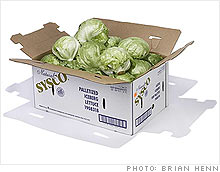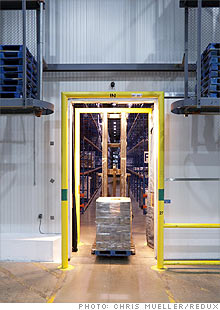Veggie tales
Think food distribution is a low-tech enterprise? Just try getting perishables across the country without sophisticated software and systems.
 |
| Sysco's scanners and software can track produce from farm to industrial kitchen. |
 |
| Parts of the Sysco facility in Front Royal, Va., are kept at -5 degrees to keep food fresh. |
(Fortune Magazine) -- When people hear the name "Sysco" they probably think of Cisco, the San Jose-based maker of routers and other high-tech gear. But Houston-based food distributor Sysco, which each year ships 21.5 million tons of produce, meats, prepared meals, and other food-related products, is pretty technologically savvy too.
The company supplies goods to one in three U.S. restaurants, cafeterias, and sports stadiums - anyplace that serves food. To get all that food safely to the right venue at the right time, Sysco maintains a complex web of software, databases, scanning systems, and robotics that surely would impress Silicon Valley types (including executives from that homonymic company).
Sysco's supply-chain logistics are especially complex because a single jar of caviar can't be handled the same way as a box of frozen onion rings or an 80-pound tub of flour. That rules out most off-the-shelf inventory-management software. So Sysco uses customized tech tools to crank out a logistical plan every day and then execute it. That way a restaurant that wants Fuji apples doesn't get Macintoshes instead, or an elementary school cafeteria doesn't end up with meals meant for the assisted-living facility down the street. In the process, the company has found ways to cut costs and speed delivery times, which is helping Sysco weather a downturn that is forcing many of its restaurant customers to cut back or close altogether.
On a recent afternoon around 5:40, a whirring noise picks up, punctuated by honks as men drive forklifts across the floor of Sysco's 450,000-square-foot facility in Jersey City, N.J. This is where restaurant supplies and food are sorted and loaded before reaching their final destination. (Sysco (SYY, Fortune 500) refers to each of its sorting centers as an "operating company.")
Every driver is wearing a wireless scanner made by Symbol, a unit of Motorola (MOT, Fortune 500), plus a printer on his hip with exact instructions on what to load on his forklift. Sysco has software that calculates exactly how each pallet - a forklift can accommodate three of the large portable platforms - should be arranged, based on the weight of its items, its location, and its destination.
"It's like the game of Tetris," says the facility's vice president of operations, Robert Heim, who says hello to everyone who drives by.
The "selectors," as the men are called, point their scanners at a bar code above an item, grab it, and put it on a pallet. The facility is arranged so that people work methodically in one direction, never doubling back, which could create chaos. The aisles are organized according to weight and temperature; heavier cans that weigh 40 to 50 pounds are put on one side of the warehouse, while lighter items, like boxes of potato chips, go on the other. It's all about maximum efficiency.
At this location 11,000 items turn over every 17 days. To achieve that, each product - even the napkins and silverware - has a kind of expiration date on it, because Sysco wants everything to move out in a particular order. If an item passes its "expiration," the inventory-management software alerts workers to pull it. Or if supplies of it are running low, they are replenished.
Thanks to the geographic spread and diversity of its customers, Sysco's trucks are seemingly everywhere. To make sure the trucks are as full as can be, Sysco in 2000 began revamping its supply-chain operations.
In the past Sysco had its food suppliers - such as Kraft (KFT, Fortune 500) and Kellogg (K, Fortune 500) - ship directly to operating centers like the one in Jersey City. The problem was that suppliers were sending a separate truck to each operating company. Not only did each truck take 2 hours to unload, but they often arrived only half full. The upshot: Sysco, which covers these suppliers' delivery costs, was wasting time and money.
Today a centralized supply-chain group in Houston, with the help of software from Manhattan Associates, directs shipments from suppliers to one of two new redistribution centers, where Sysco workers consolidate and pack into trucks large quantities of supplies before sending them on to the appropriate operating companies. In some cases the redistribution centers can get pallets for customers packed and ready, so the operating companies need to assemble only a few more pallets before sending the truck out for delivery.
The result: Fewer trucks on the road - each one fuller - and Sysco spends less time turning products around. Sysco says that in the first three quarters of fiscal 2009 it increased shipped cases per employee (a key metric of efficiency) 5%.
Sysco has also saved money by revamping its truck routes. That became imperative last year when fuel prices skyrocketed. It uses Roadnet, a software program developed by UPS, to determine the most efficient routes for its trucks. In the past nine months, the company says, diesel usage is down almost 8% from a year earlier. It also is trying to get all its units to coordinate by moving to an SAP software platform, which should take a few more years to complete.
Sysco's technology not only helps the company run more efficiently, but can aid government agencies after outbreaks related to tainted food. When the Food and Drug Administration ordered the recall of salmonella-contaminated peanut products supplied by Peanut Corp. of America last year, Sysco quickly identified six operating companies that potentially carried tainted goods. The company says it also used its tracking software to help the FDA investigate the sources of contamination by triangulating information about its shipments, eateries that had reported outbreaks, and the suspected ingredients. Using that kind of information, Sysco also helped health officials identify sources of contamination during the 2006 spinach E. coli outbreak.
As for Sysco's tech doppelganger in California, Bill Day, Sysco's senior vice president of supply chain, says that he met Cisco CEO John Chambers in 2007 and that they had a good laugh over the frequent mix-ups. Funnily enough, the companies in 2008 were ranked next to each other on the Fortune 500: Sysco came in at No. 70, with $35 billion in revenue, and Cisco ranked No. 71, with $34.9 billion. (This year Cisco is No. 57, with $39.5 billion in revenue, and Sysco is No. 62, with $37.5 billion.) In fact, Sysco is a loyal Cisco customer. Proclaims Day: "I'm talking to you on a Cisco phone." ![]()
-
 The retail giant tops the Fortune 500 for the second year in a row. Who else made the list? More
The retail giant tops the Fortune 500 for the second year in a row. Who else made the list? More -
 This group of companies is all about social networking to connect with their customers. More
This group of companies is all about social networking to connect with their customers. More -
 The fight over the cholesterol medication is keeping a generic version from hitting the market. More
The fight over the cholesterol medication is keeping a generic version from hitting the market. More -
 Bin Laden may be dead, but the terrorist group he led doesn't need his money. More
Bin Laden may be dead, but the terrorist group he led doesn't need his money. More -
 U.S. real estate might be a mess, but in other parts of the world, home prices are jumping. More
U.S. real estate might be a mess, but in other parts of the world, home prices are jumping. More -
 Libya's output is a fraction of global production, but it's crucial to the nation's economy. More
Libya's output is a fraction of global production, but it's crucial to the nation's economy. More -
 Once rates start to rise, things could get ugly fast for our neighbors to the north. More
Once rates start to rise, things could get ugly fast for our neighbors to the north. More







